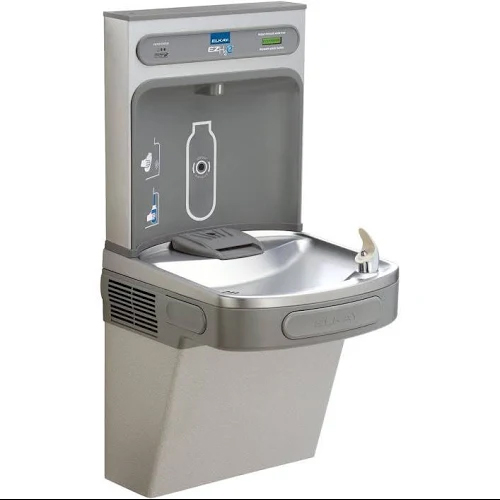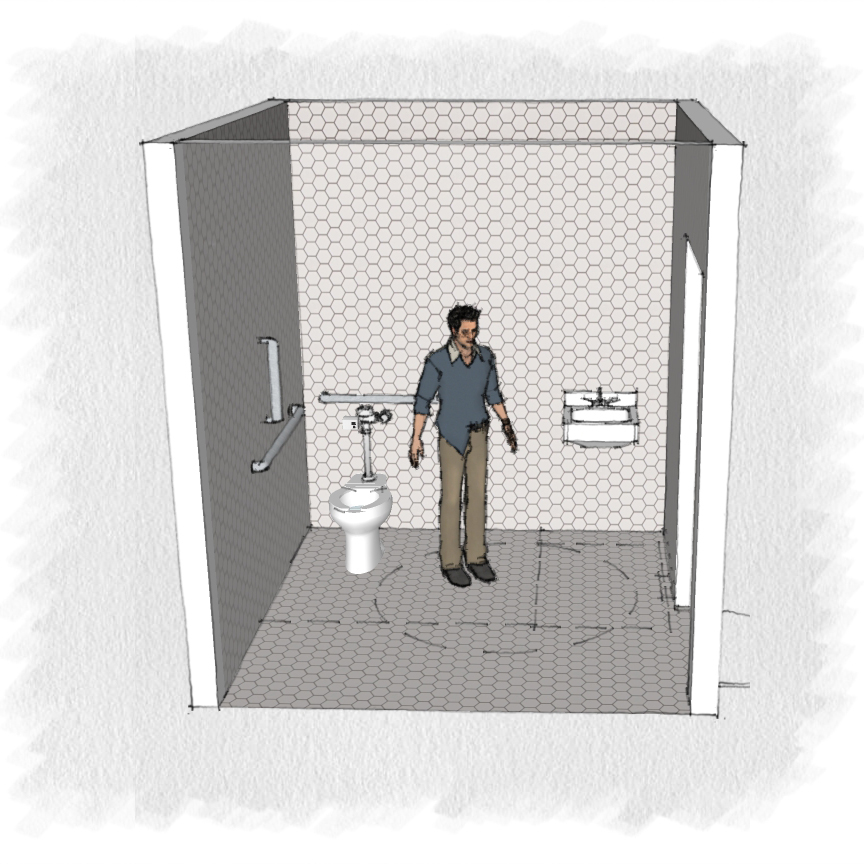
by Jeff Serbin | Oct 9, 2018 | ADA, architect in Arizona, Architectural Planning, Architecture, Blog, building code, Uncategorized
What is the Minimum size of a Bathroom? Does you current room meet ADA and building codes requirements? Are you building a new Bathroom and unsure of the correct size? Clearance and maneuverability is the driving factor to the size of a Bathroom. In a large building, may not big a big concern, as the percentage of area is minimal. When designing for a small commercial office or retail space, a Bathroom can take up valuable real estate.
As an Architect, I interact with clients, engineers and contractors who have acquired bits of information about Building Codes. Sometimes, those bits are misconceptions and regurgitated information. The building codes can be intimidating and have no beginning or end. To learn the code, the best way is jumping in feet first.
Upcoming Blog Posts
In the next series of blog posts, I will explore common Building Codes. Each City has adopted a code but most in Arizona use the IBC (International Building Code).
The following blog posts are:
- Door swing direction. Which way should the door swing, out of a room or in?
- Number of exits within a room?
- Door Size. Who said “size doesn’t matter.”
- Exit corridor width. How narrow can a hallway be?
- Clearances around a door? Door arrangement between two doors.
- Door fire ratings. What is the rating?
- Exit Travel Distance
- Do I need an elevator?
- Should my door have panic hardware?
- Do I need a drinking fountain?
- Minimum size of a Bathroom?
- Small commercial space, is one bathroom enough?
The item in bold are addressed in this post. As an Arizona Architect, most City’s jurisdictions work with the IBC (International Building Code). This code analysis is based upon the IBC.
Minimum Size of a Bathroom?
When designing a building, creating an efficient plan is important. Having a little extra space in an office, conference room or lobby is not a big problem. Who wants to have wasted space in a Bathroom? It really becomes critical when designing smaller spaces. In retail or office spaces ranging from a few thousand square feet, a Bathroom can take up valuable real estate.
Size of a Bathroom depends on orientation of the fixtures and the swing of the door, swing meaning into the room or out. See “door swing direction” blog for more information.
A few rule of thumbs for Bathrooms:
Rule # 1 – Doors shall not swing into the clear space or required clearance for any plumbing fixture. Fixtures would be mainly toilet and the sink. What is the clearance around a toilet or sink you may ask? They are as follows:
- Sink clearance – 30″ wide x 48″ deep (shown dashed on floor plans below). Note – Knee clearance can extend under a sink 25″ maximum, assuming you have a wall hung sink.
- Toilet clearance – 60″ wide x 66″ deep (shown dashed on floor plans below)
Rule # 2 – Required clear floor spaces, clearance at plumbing fixtures and turning space shall be permitted to overlap.
- Turning space – 60″ diameter circle within rest room.
Graphic examples of typical Bathroom with one toilet in varying configurations. Note that in all examples, door swing does not encroach on plumbing fixture clearances.
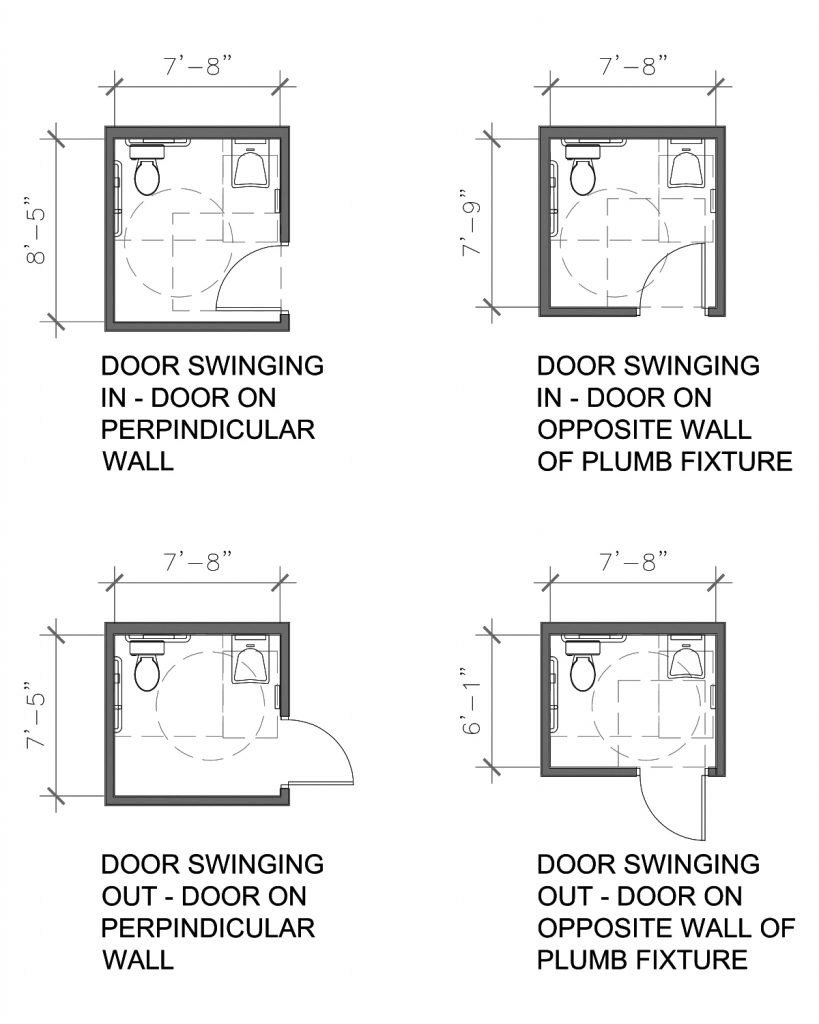
Minimum Size of a Bathroom
When swinging the door out of the room, it is possible to make the room the the smallest. I typically like to make the room just a tad bit larger than required by 1″ – 2″ to take into account construction tolerances and to make sure thickness of materials (ie. tile) or other unforeseen items don’t create a conflict.
Summary
When creating a new single person Bathroom, make it as efficient in size. Not only are you saving space in a building, it is more cost effective use of building materials. The ADA is a driving factor for the minimum size of a Bathroom. Plumbing fixture clearances are designed so occupants can easily use the restroom whether able bodies or in a wheelchair. Follow the examples above for reference but as always, refer to the local jurisdiction, the current ADA guidelines and a local professional to ensure your projects success.

by Jeff Serbin | Sep 11, 2018 | ADA, Architecture, Blog, building code, Uncategorized
Do I need a drinking fountain? As an Architect, I interact with clients, engineers and contractors who have acquired bits of information about Building Codes. Sometimes, those bits are misconceptions and regurgitated information. The building codes can be intimidating and have no beginning or end. To learn the code, the best way is jumping in feet first.
Upcoming Blog Posts
In the next series of blog posts, I will explore common Building Codes. Each City has adopted a code but most in Arizona use the IBC (International Building Code).
The following blog posts are:
- Door swing direction. Which way should the door swing, out of a room or in?
- Number of exits within a room?
- Door Size. Who said “size doesn’t matter.”
- Exit corridor width. How narrow can a hallway be?
- Clearances around a door? Door arrangement between two doors.
- Door fire ratings. What is the rating?
- Exit Travel Distance
- Do I need an elevator?
- Should my door have panic hardware?
- Do I need a drinking fountain?
- Minimum size of a single person toilet room?
- Small commercial space, is one bathroom enough?
The item in bold are addressed in this post. As an Arizona Architect, most City’s jurisdictions work with the IBC (International Building Code). This code analysis is based upon the IBC.
Do I need a drinking fountain?
Do you ever wonder when you need an automatic drinking fountain in your office, your store, your warehouse?

The building codes IBC (International Building Code) and IPC (International Plumbing Code) both discuss when a drinking fountain is required. Local jurisdiction may have overriding amendments. The information below states the requirements as interpreted from the current 2018 IBC/IPC.
CODE
Drinking fountains are required in all occupancy types except:
- Hotels
- Motels
- Boarding houses
- Residential apartments
The quantity of drinking fountains vary dependent on occupancy type, however the range is from 1 per 100 to 1 per 1,000. The following are the basic requirements:
- Drinking Fountain is not required in small occupancies per 2018 IBC/IPC for occupant loads less than 15.
- Per City of Phoenix Code Amendments, Drinking Fountains are not required for occupant loads less than 50. – Check local jurisdiction to determine code amendments.
- Where drinking fountains are required, not fewer than two drinking fountains shall be provided. One fountain to comply with wheelchair (36″ max. spout a.f.f.) and one for standing (~40″).
Exceptions or substitution:
- Restaurants which provide drinking water for free are not required to have drinking fountains
- Water dispensers shall be permitted to be substituted for not more than 50% of the required number of drinking fountains. (Interpretation – Drinking fountain with a bottle filler option, would satisfy the requirement for two drinking fountains).
- Drinking fountains shall not be required in tenant spaces provided that public drinking fountains are located within 500 feet and not more than one story above/below tenant space.
- In covered or open malls, drinking fountains shall not be required in tenant spaces provided that they are located within 300 feet.
Products
As water bottles have become more popular, bottle filling drinking fountain stations have become more prominent. In 2010, Elkay introduced a new drinking fountain. It was in response to consumer demand and environmental concerns of disposable bottles.
The product notifies the number of water bottles saved. Product notifies user to change filter as needed. This ensures and reinforces to the user that the water is safe to drink.
ADA
At least one drinking fountains installed must meet ADA requirements. Spout height at 36″ above finish floor maximum.
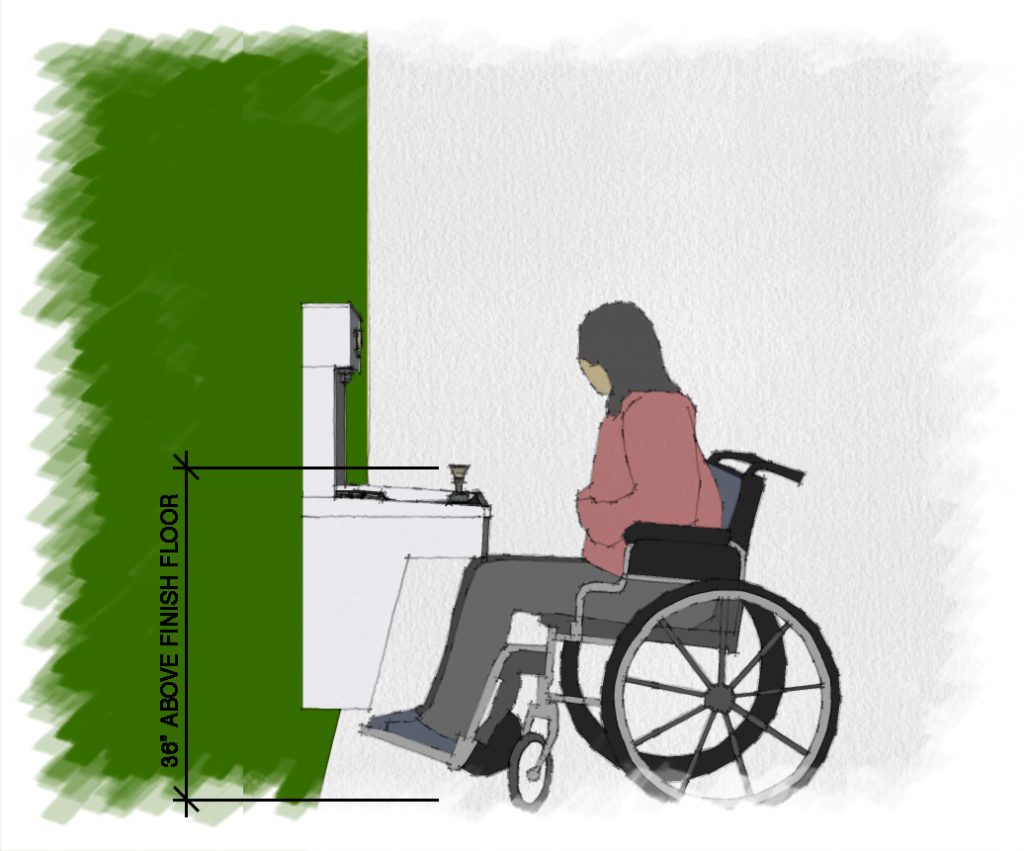
ADA sketch
The 2010 ADA standards does indicate, Section 211.2 Minimum Number – No fewer than two drinking fountains shall be provided. One drinking fountain shall comply with 602.1 through 602.6 and one drinking fountain shall comply with 602.7.
Exception: Where a single drinking fountain complies with 602.1 through 602.7, it shall be permitted to be substituted for two separate drinking fountains.
So what does 602.7 change to make it possible for one drinking fountain. Essentially the Spout has to be between 38″ minimum and 43″ maximum above the finish floor. This is higher than what is depicted in section 602.4 Spout height, which indicates 36″ a.f.f.
Summary
Do I need a drinking fountain? Drinking fountains are essentially required unless you have minimum occupants. Less than 15 occupants per IPC code and in some jurisdictions, such as Phoenix, less than 50 occupants. Where a drinking fountain is required, fixtures need to meet ADA requirements.

by Jeff Serbin | Aug 22, 2018 | ADA, Blog, building code, Uncategorized
Do I need an Elevator? – Building Codes
As an Architect, I interact with clients, engineers and contractors who have acquired bits of information about Building Codes. Sometimes, those bits are misconceptions and regurgitated information. The building codes can be intimidating and have no beginning or end. To learn the code, the best way is jumping in feet first.
Upcoming Blog Posts
In the next series of blog posts, I will explore common Building Codes. Each City has adopted a code but most in Arizona use the IBC (International Building Code).
The following blog posts are:
- Door swing direction. Which way should the door swing, out of a room or in?
- Number of exits within a room?
- Door Size. Who said “size doesn’t matter.”
- Exit corridor width. How narrow can a hallway be?
- Clearances around a door? Door arrangement between two doors.
- Door fire ratings. What is the rating?
- Exit Travel Distance
- Do I need an elevator?
- Should my door have panic hardware?
- Do I need a drinking fountain?
- Minimum size of a single person toilet room?
- Small commercial space, is one bathroom enough?
The item in bold are addressed in this post. As an Arizona Architect, most City’s jurisdictions work with the IBC (International Building Code). This code analysis is based upon the IBC.
Do I need an Elevator?
Most 2+ story buildings have elevators. Every once in a while, you may come across an older building that does not have an elevator. When is an elevator required by code?
Per the IBC, at least one accessible route ‘Elevator’ shall connect each accessible level, including mezzanines, in multilevel buildings except:
“Areas not greater than 3,000 square feet and are located above or below accessible levels.”
Exceptions:
- Group M (Mercantile) occupancies containing five or more tenant spaces
- Levels containing offices of health care providers
- Passenger transportation facilities and airports

Per ADA, Elevators are the most common way to provide access in multistory buildings. Exceptions:
“Elevators are not required in facilities under three stories or with fewer than 3,000 square feet”
Exceptions:
- Shopping Center or mall
- Professional office of health care provider
- Public transit station
- Airport passenger terminal
Examples
Scenario 1 – A four-story building has 2,900 square feet per floor. An elevator is not required because each floor is less than 3,000 square feet
Scenario 2 – A four-story building has 3,500 square feet on first floor and 2,500 square feet on each of the other floors. An elevator is required. (All of the stories must be under 3,000 square feet to quality for the exemption.)
Scenario 3 – A two-story building will be used as a real estate office. There will be bathrooms on both ground floor and second floor. Stories are less than 3,000 square feet each. Elevator not required due to exemption. Do the restrooms on second floor need to be ADA compliant? Yes. Restroom on second floor regardless of elevator exemption must be ADA compliant. Why you may ask? There are individuals who may walk up stair using crutches. In addition, ADA contains accesbility features for individuals with disabilities other than those who use wheelchairs.
Definition – “Story” – “Occupiable’ space, designed for human occupancy and equipped with one or more means of egress, light and ventilation. Basements is an occupiable space. Mezzanines are not stories. They are levels within stories.
Summary
Do I need an Elevator? Elevators are not required in all buildings greater than 2 stories. Buildings with footprints less than 3,000 square feet may qualify for an exemption. However all other components (restrooms, counter top heights, door clearances etc.) upon the stories will need to comply with ADA requirements

by Jeff Serbin | Aug 21, 2018 | Architectural Planning, Blog, building code, Uncategorized
Exit Travel Distance – Building Codes
As an Architect, I interact with clients, engineers and contractors who have acquired bits of information about Building Codes. Sometimes, those bits are misconceptions and regurgitated information. The building codes can be intimidating and have no beginning or end. To learn the code, the best way is jumping in feet first.
Upcoming Blog Posts
In the next series of blog posts, I will explore common Building Codes. Each City has adopted a code but most in Arizona use the IBC (International Building Code).
The following blog posts are:
- Door swing direction. Which way should the door swing, out of a room or in?
- Number of exits within a room?
- Door Size. Who said “size doesn’t matter.”
- Exit corridor width. How narrow can a hallway be?
- Clearances around a door? Door arrangement between two doors.
- Door fire ratings. What is the rating?
- Exit Travel Distance
- Do you need an elevator?
- Should my door have panic hardware?
- Do I need a drinking fountain?
- Minimum size of a single person toilet room?
- Small commercial space, is one bathroom enough?
The item in bold are addressed in this post. As an Arizona Architect, most City’s jurisdictions work with the IBC (International Building Code). This code analysis is based upon the IBC.
Exit Travel Distance
The maximum exit travel distance allowed by code is determined by the ‘Means of Egress’. The basic definition is as follows:
Common Path of Egress Travel – ‘That portion of exit access which the occupants are required to traverse before two separate and distinct paths of egress travel to two exits are available. The exit access is the component which leads you from the occupied portion of the building to an exit.’
Several factors within a building may require a 2nd exit from a space. The two most common triggers are occupancy quantities (ex. exceeding 49 occupants in an office space) or exceeding the allowable travel distance.

Below is an example of a scenario where occupancy calculation ( quantity of occupants) didn’t trigger a second exit. Travel distance triggered a second exit.
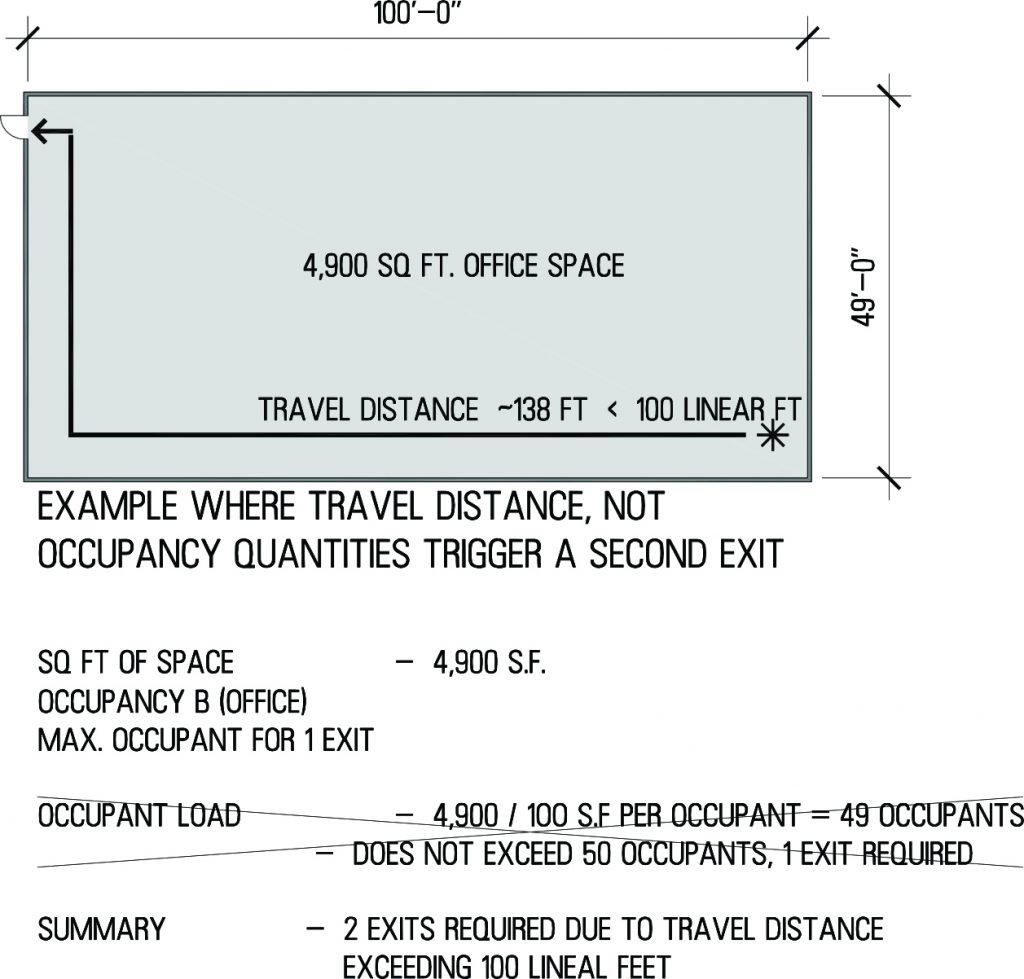
Storage spaces, Warehouses, manufacturing, Agricultural building etc. which are low in occupancy quantities will require a 2nd exit if travel distance allowable is exceeded.
Summary
The Common Path of Travel is the distance an occupant must travel to exit a building. In some scenarios, occupancy calculations dictate that a 2nd exit is required. Where occupancy quantities are low and the Common Path of Travel exceeds the distance allowable, a second exit is required. Follow the examples above for reference but as always, refer to the local jurisdiction and a local professional to ensure your projects success.
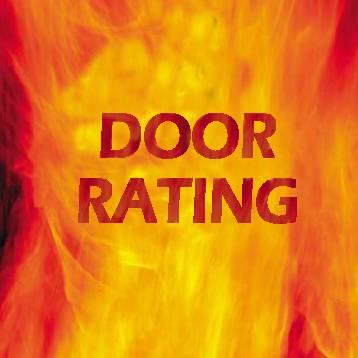
by Jeff Serbin | Aug 17, 2018 | Blog, building code, door, Uncategorized
Door Fire Rating – Building Codes
As an Architect, I interact with clients, engineers and contractors who have acquired bits of information about Building Codes. Sometimes, those bits are misconceptions and regurgitated information. The building codes can be intimidating and have no beginning or end. To learn the code, the best way is jumping in feet first.
Upcoming Blog Posts
In the next series of blog posts, I will explore common simple and more complex Building Codes. Each City has adopted a code but most in Arizona use the IBC (International Building Code).
The issues to be addressed in the following blog posts are:
- Door swing direction. Which way should the door swing, out of a room or in?
- Number of exits within a room?
- Door Size. Who said “size doesn’t matter.”
- Exit corridor width. How narrow can a hallway be?
- Clearances around a door? Door arrangement between two doors.
- Door fire ratings. What is the rating?
- Exit Travel Distance.
- Do you need an elevator?
- Should my door have panic hardware?
- Do I need a drinking fountain?
- Minimum size of a single person toilet room?
- Small commercial space, is one bathroom enough
The item in bold is addressed in this post. As an Arizona Architect, most City’s jurisdictions work with the IBC (International Building Code). The code analysis is based upon the IBC.
Door Fire Rating
A door is part of the ‘Means of egress’ of a building. The wall rating determines the rating of the door assembly. A door and its components, glazing and hardware will have different required ratings. Wall ratings fall within 1 hour increments, ranging from 1 to 4 hours. The rating describes the ability of the wall to ‘prevent the spread of fire’ from adjacent spaces or buildings.
There are actually three main classifications of fire walls: Fire walls, Fire barriers and fire partitions.
Fire Wall – ‘A fire resistance-rated wall having protected openings, which restricts the spread of fire and extends continuously from the foundation to or through the roof, which sufficient structural stability under fire conditions to allow collapse of construction on either side without collapse of the wall.’ Useful in fire separation of occupancy types.
Fire Barrier – ‘A fire-resistance-rated wall assembly of materials designed to restrict the spread of fire in which continuity is maintained’
Fire Partitions – ‘A vertical assembly of materials designed to restrict the spread of fire in which openings are protected.’
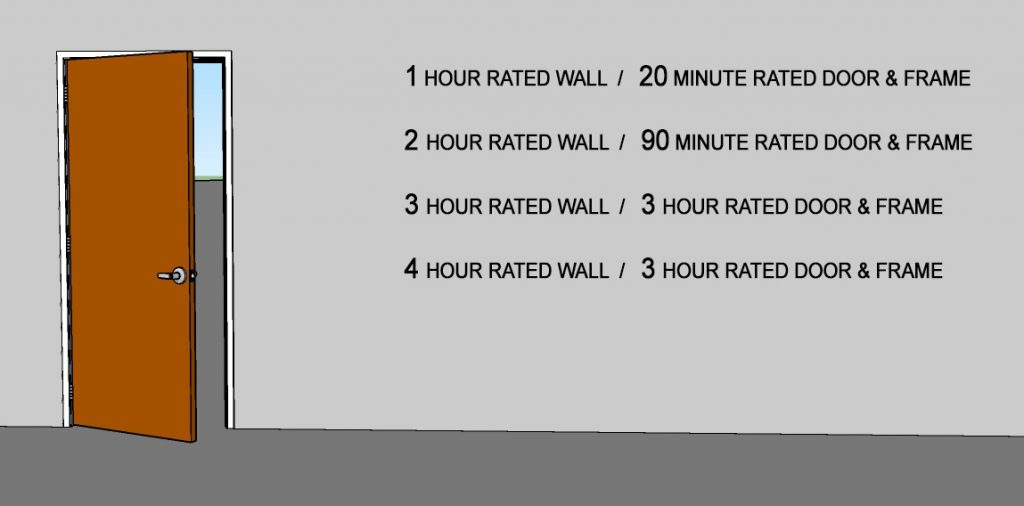
Door Fire Rating
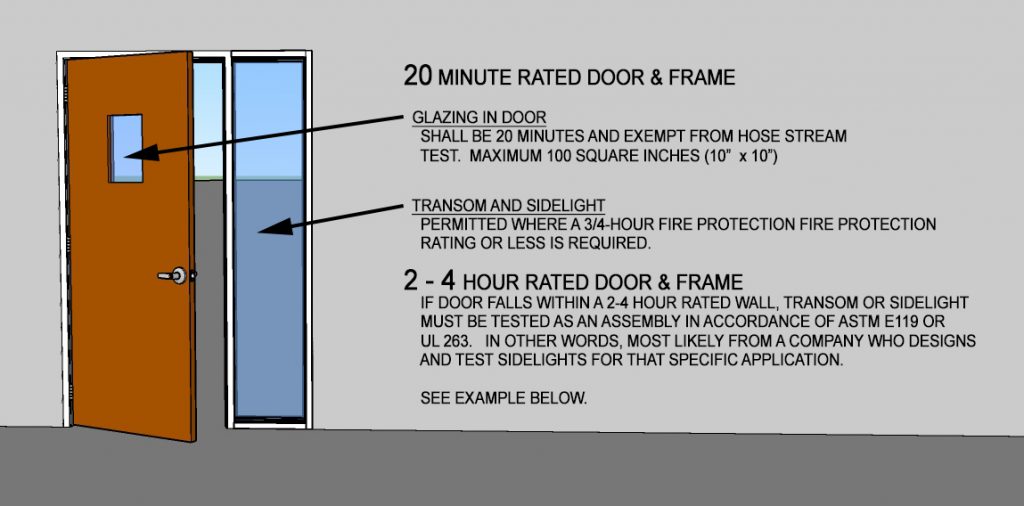
Door Fire Rating – Glazing
Specialty Frame Assemblies
For glass doors that require 20-120 minute rated conditions, there are numerous manufacturers who have design and tested systems. A few examples are Safti First, Fireglass, Aluflam etc. They design window door assemblies with glazing for specific rated conditions. The glazing manufacturer determines the size of the glazing based upon its constraints. A few examples are links to various types of glazing available or manufacturers who can assist you to determine the best system. The size of the glazing will depend on the type of glazing they offer within their systems.
Fireglass.com – Firelite Plus – Available in 20 min to 3 hour rating
Pilkington – Pyrostop – Available in 20 min. to 3 hour rating
Safti.com – Superlite II-XLM120 – Available up to 120 minute rating
I recommend researching either with a system manufacturer to determine the type of door/window system and glazing type that best suites your project needs.
Summary
Fire rated doors and their glass required ratings are determined upon the required rated of the wall assembly. Door rating doesn’t quite match the wall rating as depicted in the example above. Windows within a rated door are restricted to only 100 sq. in. Sidelights can be as large as a window manufacturer ability to rate its glazing. To determine what is required for your project, hire an expert or contact a company specializing in fire rated assemblies.




